Guide to Winter Growing
When the days shorten and the remainder of the natural world goes into hibernation, we continue to need quality local food. Winter farming is key to maximizing productivity of small urban farming spaces. The vigorous summer cycle takes a lot out of the soil and winter gives us the chance to rejuvenate our soils by aerating, adding compost and feeding the soil food web. We do this without interrupting our crop rotation or planting schedule, as we transition to winter crops. We also transition from production for farmers markets to our winter CSA.
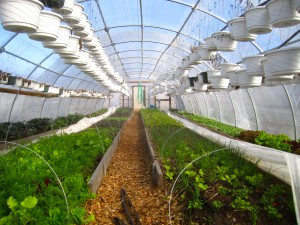
ECO City Farms is one of the few year-round farms in our region. We are committed to learning, innovating and continuing to develop successful strategies for winter growing. This involves using appropriate tools for the urban farmer, including hoophouses, row covers, coldframes, geothermal and compost heat. We also must choose the most appropriate and productive plants for the winter harvest and market our winter produce in ways that work for the farm and the consumer. Read on for more about how we are incorporating all these strategies at our Edmonston farm in 2011-2012.
Tools for Winter Growing
Hoophouses
A hoophouse, or high tunnel is a critical tool for winter growing. An unheated, ie: passively heated hoophouse will provide enough protection to grow year round a plenitude of greens and roots. We have spent the past two years improving on the design of our hoophouses which now include roll-up sides for proper ventilation & raised beds.
Simple row covers insulate the soil heat from the air and provide plants protection from the cold. With two layers of protection, when combined row covers with a hoophouse, you can create the growing conditions of winter in the Carolinas, a full two hardy zones south of Maryland.
Coldframes
Cold frames are like mini-greenhouses, they add an extra layer of protection and create a micro-climate that is favorable to plant growth. Coldframes are easy to construct from old used windows or sliding glass doors and provide superior protection compared to row-covers.
Our geothermal system, also called earth-tubes or a ground coupled heat exchanger, helps regulate the daily fluctuations in temperature by pumping consistently ground temperature (55degrees) air through the hoophouse. The flow and heat exchange of air with the soil ground temperature creates a heat convection loop in the hoophouse that helps keep nighttime lows from dipping below freezing.
A properly built compost pile can produce temperatures up to 150 degrees. We can harness that heat by trapping it in microclimates. This example of a hotbed demonstrates how a compost pile insulated by strawbale walls can concentrate heat, allowing for seedlings to be germinated even in the dead of winter!
The Winter Harvest
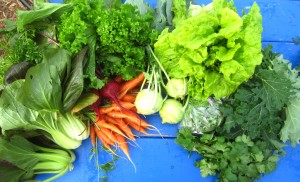 Plants will grow much slower during the winter months, but there are also nearly no pests or diseases to troubleshoot. We often remark that with the right tools, winter growing is easier than the rest of the year because the amount of work is actually much less. Choosing the right crops is important to successful winter growing, when purchasing seed, check for availability of cold tolerant varieties. You will have the most success with traditionally cold tolerant crops:
Plants will grow much slower during the winter months, but there are also nearly no pests or diseases to troubleshoot. We often remark that with the right tools, winter growing is easier than the rest of the year because the amount of work is actually much less. Choosing the right crops is important to successful winter growing, when purchasing seed, check for availability of cold tolerant varieties. You will have the most success with traditionally cold tolerant crops:
Brassicas: Kale, Collards, Kohlrabi, Turnips, Brussel Sprouts, Broccoli, Cauliflower, Cabbage.
Root crops: carrots, beets, radishes, rutabagas, celery, scallions, leeks and onions.
Leafy greens and cooking greens: salad mixes, Lettuces, Mustard greens, Swiss Chard, Arugula, Spinach, Pac Choi, Mache, Watercress and Parsley.
There is a big demand for fresh produce in the winter, when local food is in decline. Chefs are beyond excited for the opportunity for fresh ingredients to get them through the winter. Some markets farmers markets operate year round by diversifying their vendors to include artisanal cheeses, baked goods, meats and other goods. We have shifted toward a winter CSA which provides shares of fresh produce to families in our community for weekly pickup at the farm from December through March.
Record Keeping & Planning: Successful growing any time of the year is about the art of observation. In the winter record keeping is key to understanding the climate and restraints of your crops in the cold weather, lack of sunlight, etc. By monitoring temperatures, microclimates and other factors will help you understand how your crops, soil and structures are dealing with the cold tempuratures. Be prepared for venting hoophouses and monitoring for overheating just as much as you are prepared for extreme cold each night.
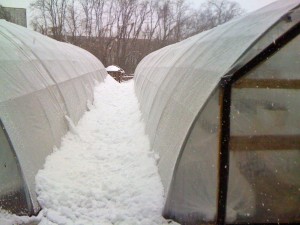 Future strategies: As we embark on a major expansion to our Edmonston farm, we are developing, experimenting and innovating new strategies for winter growing. We are preparing for the construction of a 92’x26′ gothic framed hoophouse which will be constructed in February on the former tennis courts. In this hoophouse we hope to scale up our microgreens and nursery space so that we can an increase propogation and production. We are currently researching the options of integrating a waste veggie oil heat system for heating benches and grow beds. We are also making moves to develop an affordable and simple low-tunnel that is moveable so we can add better utilize winter growing on the remainder of our farm. We welcome others to share their winter growing successes and innovations, particularly in the Chesapeake Foodshed.
Future strategies: As we embark on a major expansion to our Edmonston farm, we are developing, experimenting and innovating new strategies for winter growing. We are preparing for the construction of a 92’x26′ gothic framed hoophouse which will be constructed in February on the former tennis courts. In this hoophouse we hope to scale up our microgreens and nursery space so that we can an increase propogation and production. We are currently researching the options of integrating a waste veggie oil heat system for heating benches and grow beds. We are also making moves to develop an affordable and simple low-tunnel that is moveable so we can add better utilize winter growing on the remainder of our farm. We welcome others to share their winter growing successes and innovations, particularly in the Chesapeake Foodshed.
~Adam Schwartz / Farm Manager, ECO City Farms / Port Towns, MD
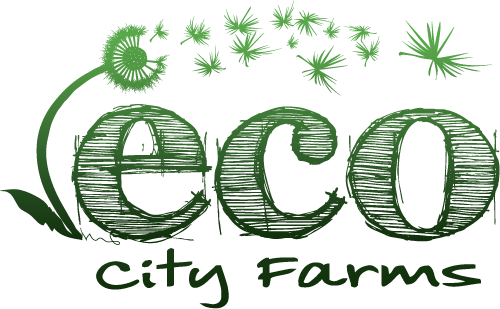

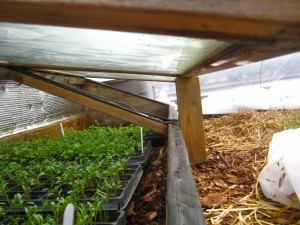
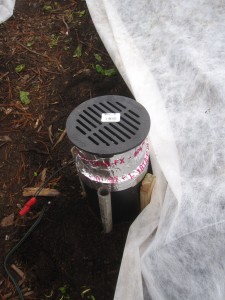

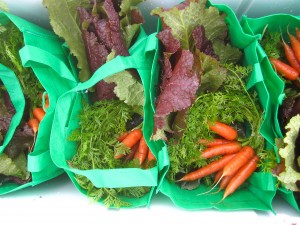
2 thoughts on “Guide to Winter Growing”